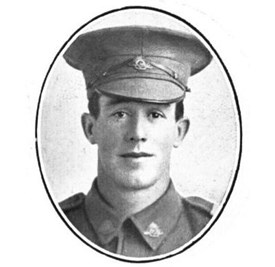Pte
Arthur Ernest Gadd
Information about birth
|
Year of birth: 1892 |
|
Place of birth: Ipswich, Queensland, Australia |
General information
|
Profession: Boilermaker |
Army information
|
Country: Australia |
|
Force: Australian Imperial Force |
|
Rank: Private |
|
Service number: 3122 |
|
Enlistment date: 03/10/1916 |
|
Enlistment place: Moore Park, Sydney, South Wales, Australia |
|
Units: — Australian Infantry, 54th Bn. (Last known unit) |
Information about death
|
Date of death: 16/10/1917 |
|
Place of death: Jabber Trench, Westhoek, Belgium |
|
Cause of death: Killed in action (K.I.A.) |
|
Age: 25 |
Memorial
|
Ypres (Menin Gate) Memorial Panel: 29 |
Distinctions and medals 2
|
British War Medal Medal |
|
Victory Medal Medal |
Points of interest 2
| #1 | Place of birth | ||
| #2 | Enlistment place |
My story
Arthur Ernest Gadd was born in Ipswich, Queensland in 1892. He joined the army in October 1916. At the time of his enlistment he was working as a Boiler Maker. In May 1917 he was taken on by “C” Company of the 54th Battalion Australian Infantry, which operated in the14th Brigade of the 5th Division.
From the 14th till the 17th of October 1917, the 54th Battalion was in reserve on the Westhoek Ridge. Its headquarters were situated in the hamlet of Westhoek. “C” Company was entrenched in Jabber Trench, along the road, which runs through the hamlet. The companies were detailed in working parties. “C” Company was assigned to carry Corkscrew Wiring pegs from the dump.
German shelling in the area around Glencorse Wood, Nonneboschen, Anzac Ridge and Westhoek Ridge had been heavy during the night 15/16th. However, from 1-5pm on 16th October, the German shelling was directly concentrated on Westhoek Ridge.
Eye-witnesses declared that Private Arthur Ernest Gadd, 25, was in a dug-out with three other men (Lance Corporal Henry George Hall (5378), Private Johnson (2924) and Private Smith (2980)), when a shell struck the dug-out. Private Gadd and Lance Corporal Hall were killed instantly and were buried near the dugout. Smith and Johnson were evacuated, but later died of their wounds.
Gadd’s brother, Private James Herbert Gadd was near him when it happened. He was also wounded on the fateful day. He later wrote home to give an account of his brother’s death. Arthur’s grave got lost in the further fighting or his remains weren’t positively identified after the War. Arthur therefore has no known grave and is remembered on the Ypres (Menin Gate) Memorial.
From the 14th till the 17th of October 1917, the 54th Battalion was in reserve on the Westhoek Ridge. Its headquarters were situated in the hamlet of Westhoek. “C” Company was entrenched in Jabber Trench, along the road, which runs through the hamlet. The companies were detailed in working parties. “C” Company was assigned to carry Corkscrew Wiring pegs from the dump.
German shelling in the area around Glencorse Wood, Nonneboschen, Anzac Ridge and Westhoek Ridge had been heavy during the night 15/16th. However, from 1-5pm on 16th October, the German shelling was directly concentrated on Westhoek Ridge.
Eye-witnesses declared that Private Arthur Ernest Gadd, 25, was in a dug-out with three other men (Lance Corporal Henry George Hall (5378), Private Johnson (2924) and Private Smith (2980)), when a shell struck the dug-out. Private Gadd and Lance Corporal Hall were killed instantly and were buried near the dugout. Smith and Johnson were evacuated, but later died of their wounds.
Gadd’s brother, Private James Herbert Gadd was near him when it happened. He was also wounded on the fateful day. He later wrote home to give an account of his brother’s death. Arthur’s grave got lost in the further fighting or his remains weren’t positively identified after the War. Arthur therefore has no known grave and is remembered on the Ypres (Menin Gate) Memorial.
Sources 7
|
Australian War Memorial https://www.awm.gov.au/advanced-search?query=gadd+3122 Sources used |
|
Australian War Memorial , War Diary https://www.awm.gov.au/collection/C1345968?image=1 Sources used |
|
CWGC https://www.cwgc.org/find-war-dead/casualty/923644/gadd,-arthur-ernest/ Sources used |
|
National Archives of Australia https://recordsearch.naa.gov.au/SearchNRetrieve/Interface/DetailsReports/ItemDetail.aspx?Barcode=4036358&isAv=N Sources used |
|
St. Claire, R., Our gift to the empire : 54th Australian Infantry Battalion, 1916-1919.,2006, pp. 143-148. Sources used |
|
The AIF project https://www.aif.adfa.edu.au/showPerson?pid=105986 Sources used |
|
The Long Long Trail https://www.longlongtrail.co.uk/ Sources used |
